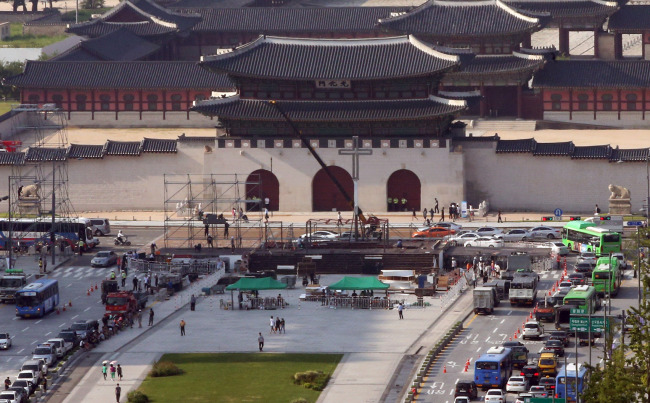When Pope Francis arrives here Thursday morning, he will find a small, but dynamic Catholic Church that he hopes will “arise and shine” on the continent and the rest of the world, where Catholicism faces grave challenges.
“The Korean Church is dynamic. Only about 10 percent of Koreans are Catholic, but it churns out many missionaries who are now planting the seeds of faith in so many countries in the world, such as Mongolia,” Vatican spokesman Federico Lombardi said during a press briefing in the city last week.
Themed “Arise, Shine (Isaiah 60:1),” Pope Francis’ apostolic voyage here will serve three main purposes: his attendance of the sixth Asian Youth Day, a gathering of young Catholics in the region, beatification of early Korean martyrs and promotion of peace and reconciliation between the two Koreas.
 |
A cross stands on a stage for a papal Mass at Gwanghwamun Square, Seoul, Wednesday. Pope Francis will celebrate the Mass to beatify 124 Korean martyrs on Saturday. (Yonhap) |
To many Vatican watchers, however, the pontiff’s 13-hour flight and five-day stay in Korea has a broader message for the 1.2 billion Catholics worldwide, highlighting a church that is growing vigorously with a positive public image, a far cry from the situation in Europe.
It signals a shift in the Vatican’s geographic focus, they say.
“His mere presence in Asia and the fact that it has already been announced that the pope will visit the Philippines and Sri Lanka in 2015 underscores the new and very significant orientation toward Asia,” said Lionel Jensen, a University of Notre Dame professor and expert on religion in Asia.
“The effects of this first Asian visit will be significant and enduring.”
Catholicism is growing strongly in Asia and Africa, but suffering a sharp decline in membership in Europe.
The pope’s Aug. 14-18 visit to Korea marks his first papal trip to Asia.
In January, the pope is to visit the Philippines, the region’s largest Catholic country, and Sri Lanka. A trip to Japan, where he wanted to be sent as a missionary when he was young, is also being considered.
The previous pope, Benedict XVI, never traveled to this region during his eight-year papacy.
For the 5.4 million-strong Catholic community in Korea, which will greet the pontiff in their homeland for the first time in 25 years, it is a chance to strengthen and expand their faith.
“I personally hope that more Koreans will turn to Catholicism (inspired by the pope),” said Father Matthias Hur Young-yup, a spokesperson for the Preparatory Committee for the Visitation of the Holy Father. “But, aside from religion and numerical achievements, I hope that the pope’s visit will heal the discord and divisions of Korean society and propagate a message of love and peace,” he said.
Hur and many other priests expressed hope that Pope Francis would shed a guiding light as Korea struggles with a high suicide rate, a low birthrate and a growing socioeconomic polarization.
Catholicism began in Korea only about 230 years ago, but it is now the third-largest faith after Protestantism and Buddhism.
The faith was first introduced here in the 18th century by Korean academics who were interested in Western studies. A Korean scholar traveled to Beijing to be baptized, and founded Korea’s first church in 1784 on his return.
Early Korean Catholics faced persecution and suppression during the Joseon Dynasty, as the religion’s principles of universal equality and rejection of traditional ancestral rites were viewed as dangerous forces disrupting Korea’s long-held social structure.
More than 10,000 Koreans have been martyred for their faith. Of them, 103 were canonized en masse by John Paul II in 1984.
On Saturday, Pope Francis will beatify Paul Yun Ji-chung, the nation’s first martyr, as well as 123 companions who were killed for their faith in the 19th century.
“These 124 were martyred for their faith before foreign missionaries entered Korea. They have been unrecognized until now because of poor recordkeeping,” said Father Yoo Hong-chun from the preparatory committee.
“I hope that the upcoming beatification will provide an opportunity to reflect on the martyrs’ faiths as well as look back on the status of the modern church and its followers,” Yoo said.
By Lee Sun-young and Sohn Ji-young
(
milaya@heraldcorp.com) (jiyoung.sohn@heraldcorp.com)








![[Weekender] Korea's traditional sauce culture gains global recognition](http://res.heraldm.com/phpwas/restmb_idxmake.php?idx=644&simg=/content/image/2024/11/21/20241121050153_0.jpg)